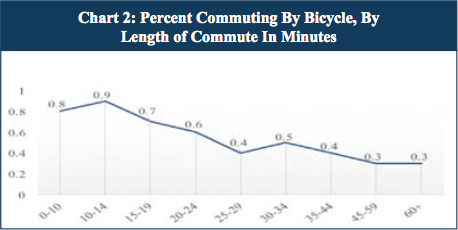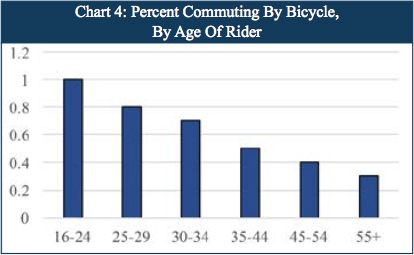Publisher's note: The author of this post is Julie Tisdale, who is City and County Policy Analyst for the John Locke Foundation.
Millions Of Your Money Spent On Vanity Projects for The 1%
Key Facts
- Bicycling remains a tiny, and largely insignificant, form of commuting with only 0.2% of commuters in Charlotte and 0.6% in Raleigh using bicycles.
- Despite millions of dollars spent on infrastructure, bicycling in North Carolina has barely grown at all over the last decade.
- North Carolina's cities don't fit the profile of easily bikeable cities, with population densities far lower than cities with large numbers of bicycle commuters.
- Government at all levels should meet the population's infrastructure needs, not drive the population to change its behavior. Building lanes for which there is little demonstrated demand in order to promote a 'green, healthy lifestyle' puts government preferences above individual choices.
Introduction
In 2015, the city of Raleigh spent $4.62 million1 on on-road bikeways. Between 2009 and 2015, Raleigh grew its bikeways from 73 miles to 179 miles.2 The city hired a Bicycle and Pedestrian Program Manager, which, when
advertised last year, had a salary range of $45,000-$76,000.
This isn't just a Raleigh phenomenon. According to the N.C. Department of Transportation (DOT),3
- The NCDOT Bicycle and Pedestrian Planning Grant Initiative provides financial assistance to local governments to plan for future bicycle and pedestrian networks. Since 2004, more than $4 million has been awarded to help more than 164 communities develop comprehensive bicycle and pedestrian plans. (emphasis added)
And yet, despite all the money being spent on infrastructure and programs, bicycling remains a tiny, and largely insignificant, form of commuting. It's remarkably difficult to find good statistics about biking, but one of the few sources available is the U.S. Census Bureau report, published in May 2014, titled Modes Less Traveled - Bicycling and Walking to Work in the United States: 2008-2012. It's useful in painting a picture of the state of bicycling across the country. Since the report examines bicycling in the whole of the U.S., local data is necessarily limited. It does, however, give statistics for the 50 largest cities in the country, which includes both Charlotte and Raleigh. Their numbers come from the 2000 Census and from the American Communities Survey, an ongoing survey carried out yearly by the Census Bureau. Across those 50 largest cities in America, only 1% commute by bicycle. In North Carolina, it is even fewer than that. (See Chart 1)

What Sort Of Biking?
It is important in any discussion of biking to distinguish between biking as transportation and biking as recreation. There are many people who enjoy biking around their neighborhoods or on greenways and trails as a form of exercise and outdoor fun. This likely replaces walking, running, and hiking activities. Then there's biking as transportation. This is people who are biking to work, to run errands, to do shopping or conduct other business, and to move their children around. While both types of biking are valuable, it's the latter that is most important when considering the investment of taxpayers' money. Transportation infrastructure that meets the needs of employers, employees, businesses, and customers is crucial for economic growth and increased employment.
Where Do People Bicycle?
There are characteristics that cities with large numbers of bicycle commuters have in common. For the most part, they're either small or have very dense populations, both of which cut down on travel distances and make bicycling more feasible as a mode of transportation. The Census data reveals that most bicycle commutes were between 10 and 14 minutes in length. For longer trips, the numbers drop off significantly. (See Chart 2)

North Carolina cities don't fit the profile of easily bikeable cities using these criteria. Their populations are relatively spread out, making biking to work difficult for most workers. Looking just at the 10 cities in the Modes Less Traveled report that have the highest rates of bicycling to work, they have an average population density of around 8,000/square mile. Raleigh's population density is around 3,000/square mile, and Charlotte's is around 2,700, explaining the low rates of bicycle commuting in North Carolina. People live farther from where they work, making a bike commute relatively difficult.
According to Census data, the lowest rates of cycling are in the South (See Chart 3). While there may be many factors that contribute to this fact - geography and density, culture, climate - it is certainly important for policymakers to recognize that biking as a form of transportation is not something that Raleighites and Charlotteans, North Carolinians, or Southerners more generally demand. Low rates of bike ridership are not just about provision of bike lanes across the region.

Not only are the numbers of people cycling in North Carolina's largest cities tiny - less than 1% - but any increases in those numbers are so small as to be statistically insignificant in the Census Bureau's data. Over roughly 10 years, and with millions of dollars in investment, the numbers remain small and are barely growing.
The Census data can be broken down further. Patterns of bike use are not uniform. In particular, they vary with age. Young people bike to work at higher (albeit still very low) rates than older workers. The rates haven't changed much between the 2000 Census and the ACS of 2008-12. As people get older, their preferences change, and fewer wish to bicycle to work or to conduct other business. (See Chart 4)

Some new, younger workers will enter the cycling group, but many slightly older workers will exit it, opting instead to travel by car. People in homes without children bike at markedly higher rates than do people in households with kids.
First, it is easier to move yourself around on a bike than it is to move yourself and a child or two around on a bike. It's not impossible to cycle with a kid, but to do so over very significant distance, accommodating both the child and all of the associated stuff (diaper bags, snacks, bottles, blankets, changes of clothes, toys), is certainly challenging. Most parents prefer to load the child in a climate-controlled car with plenty of space for all of that stuff. (See Chart 5)

Second, we know that, as people have children, they tend to move to out of cities and into suburbs with single-family houses and private yards. Certainly not all people do this, but there is a general pattern. Thus, parents tend to live farther from the places where they work, shop, and do other business. And as indicated previously, longer commutes are less likely to be done by bicycle.
The Raleigh Bicycle Plan
Raleigh's bicycle plan, while only directly affecting Wake County, is useful in revealing the sort of thinking behind spending on bicycle infrastructure across the state. What becomes apparent very quickly when reading the Raleigh bicycle plan, however, is that the low ridership numbers don't really matter to planners. Of course, they'd like the numbers to be higher, but the language in the plans is a mix of aspiration and moral superiority.
- ...policies can establish a new social norm where bicycling is seen as practical and appealing for people of all ages and abilities by providing for the infrastructure and amenities to support healthy choices and active transportation. (Raleigh Bike Plan Update, 7-1, emphasis added)
Or this:
- There are a number of additional policies and council actions at the local, regional, and state level that highlight and support the importance and benefit of a shift from drive-alone automobile trips to biking trips.
- To further Raleigh's effort to adopt a policy framework that reflects the desire to increase bicycle transportation, the following new policy and action items are recommended:... (Raleigh Bike Plan Update, 7-9, emphasis added)
There's even language that seems downright punitive toward motorists.
- It is recommended that Raleigh develops a strategy for bicycle facility maintenance and policies to support it. In addition, Raleigh bicyclists commonly report parked cars and other obstacles in bicycle lanes. The City should target offenders with education/enforcement strategies. (Raleigh Bike Plan Update, 7-7, emphasis added)
Policy Implications
Infrastructure, like bike lanes, either diverts money
from other sorts of road projects or reduces existing capacity for motorized transportation on roads by converting some portion of that paved space to lanes reserved for bicycle traffic. This sort of approach is evident on streets around Raleigh, among other places, where roads have been changed from two lanes in each direction to one in each direction plus a central turn lane, or where a central turn lane has been lost, all in order to add bike lanes to the existing pavement.
Census data show that converting roads by using limited transportation resources to build new bike lanes is a poor use of those resources. Government at all levels - local, state, and federal - should be about meeting the infrastructure needs of the population, not driving that population to change its behavior. Building lanes for which there is little demonstrated demand in order to promote a "green, healthy lifestyle" is to put the preferences of government above the choices of individuals.
Leaders at the N.C. DOT and in North Carolina's cities should rely on demonstrated widespread demand for bike infrastructure before spending tax dollars on these projects. They should weigh that against the negative impact on the vast majority of employees, business owners, and consumers who choose to travel by car. Bike lanes reduce the number of lanes available for cars and parking, increasing congestion and travel times. Money spent on that bicycling infrastructure reduces the money available for improving roads used by the vast majority who travel by car. The needs of that majority should not be ignored to impose the "green, healthy lifestyle" goals of legislators and city councillors.
Endnotes
- State of Bicycling in Raleigh 2015 Report, p.11, Bike Raleigh, bikeraleigh.org/home/index.php/projects/bike-raleigh-plan
- Ibid, p9
- http://www.ncdot.gov/download/newsroom/FastFacts.pdf





